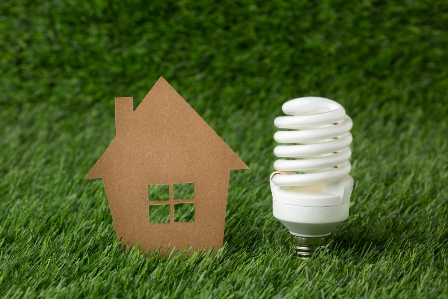Sustainability helps homeowners reduce energy bills and make their residences more comfortable. Energy-efficient houses promise better air quality and keep your family safe from pollutants. Also, you can increase your property’s resale value. In this fast-paced world, where energy consumption is rising, energy-efficient homes contribute to increased sustainability. Here are some tips to help you transform your home into an energy-efficient living space:
1. Use energy-efficient bulbs
Replace all old bulbs with energy-saving LEDs as they last longer, shine more brightly, and reduce energy consumption. Some sources claim that LED bulbs last 35 to 50 times longer than incandescent bulbs and 2 to 3 times longer than fluorescent bulbs. So, even if LEDs seem pretty expensive than regular bulbs, they can be a very affordable investment in the long run. Also, they are good for the environment.
2. Replace your drafty windows
Around 10% of the heat in your house can escape through drafty windows and unsealed doors. So, it is time you tackle this problem and make your house more energy-efficient by replacing your windows. Damaged windows don’t prevent cold wind from entering your house and disrupting the environment inside. You can call up a window replacement contractor to fix this problem. Get energy-efficient all weather seal windows to reduce energy loss and save on utility bills.
3. Update your HVAC system
Keep your HVAC system updated by monitoring it. Routine maintenance and an occasional visit by the service provider are essential for ensuring a fully functional HVAC system. Here’s how you can maintain your HVAC system and reduce energy costs successfully:
- Change its filters and get some with a MERV rating between 7 and 13
- Keep your HVAC unit clean and make sure there’s no clutter around it
- Maintain your carbon monoxide detector and replace its batteries if necessary
4. Install solar panels
Solar panels capture the Sun’s energy and transform it into electrical power. You should switch to solar power and reduce your overdependence on fossil-fuel energy. As of 2022, 4% of US homes have installed solar panels to reduce their carbon footprint and generate electricity in an Earth-friendly way. Solar panels are easily affordable, and they add to your house’s value.
Solar panels last for 18 to 22 years and give you $1,500 worth of savings in a year. It means that you’ll save more than $30,000 annually during the lifetime of your solar panels.
5. Get a programmable thermostat
You can purchase programmable thermostats for less than $100 online to boost your place’s energy efficiency. These devices cut down your utility bills by 10% every year by automatically adjusting the temperature based on what is required. When sleeping or away from your house, this device lets you adjust the temperature settings to save energy. A programmable thermostat ensures a comfy environment for your loved ones while tracking and analyzing your energy usage patterns.
6. Let the sunlight in your house
There’s no alternative to natural sunlight, so you should keep the blinds open in the morning and avoid artificial lighting during the day. Sunlight doesn’t just reduce your utility bills, but also improves the well-being of your family. Moderate exposure to natural sunlight uplifts your mood and helps you overcome depression. A properly sun-lit house is a pretty energy-efficient dwelling.
7. Fix visible gaps and cracks
You can significantly reduce energy waste, lower HVAC costs, and make your house more comfortable by sealing gaps, holes, and cracks in your home. Seal air leaks via proper insulation to prevent heat from escaping through these openings in the winter. You can fix visible cracks by:
- Inspecting your home and looking for gaps
- Insulating your attic by using fiberglass or cellulose insulation
- Insulating crawl spaces via foam board insulation or spray foam
- Using caulk or weather stripping to seal gaps around doors and windows
- Using door sweeps and thresholds to seal gaps at the bottom of doors properly
8. Insulate your house properly
Do you know that your walls and ceilings are responsible for one-third of heating losses? Insulate your walls, floors, and ceilings to make your house more energy-efficient. Installing adequate insulation in your home prevents heat gains in the summer and heat losses in the winter. Insulating materials hinder unwanted temperature fluctuations, keeping your family safe and cozy.
The trick is to reduce heat flow from invisible cracks and holes in your domestic structure. You can stabilize your house’s indoor temperature effectively by using quality insulating materials.
9. Insulate your water heater tank
Consider insulating your water heater to reduce its cost by 7 to 16 percent and overcome standby heat losses. This insulation helps retain heat, reduces the workload on your water heater, and lowers energy costs significantly. You can insulate your water heater the DIY way by following these simple steps:
- Gather insulating supplies, such as duct tape, utility knife, and measuring tape
- Make sure the water heater is turned off and completely cool to avoid any accidents
- Measure your water heater tank’s height and circumference to find the size of the blanket
- Wrap the appropriately-sized blanket around the tank, trim the excess material, and secure it with duct tape
- Avoid covering any vents, access panels, or controls on the water heater, as these areas should remain unobstructed
Conclusion
If you intend to make your home more environmentally friendly and cost-effective, then pursuing energy efficiency is the way to go forward. You’ll reduce your utility bills and create a more comfortable indoor environment by following the guidelines mentioned in this blog. Use energy-efficient bulbs, install quality solar panels, and replace your thermostat with a programmable one. Insulate your walls and floors, as well as ceilings and water heaters. Also, replace your windows to make your house more energy-efficient. Taking these steps can help you save a considerable amount of money on your energy bills.









